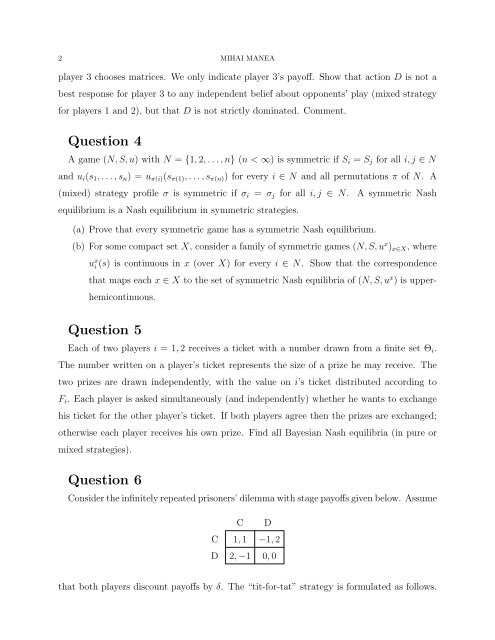14.126 Spring 2010 Homework 1 - MIT OpenCourseWare
14.126 Spring 2010 Homework 1 - MIT OpenCourseWare
14.126 Spring 2010 Homework 1 - MIT OpenCourseWare
Create successful ePaper yourself
Turn your PDF publications into a flip-book with our unique Google optimized e-Paper software.
2 MIHAI MANEA<br />
player 3 chooses matrices. We only indicate player 3’s payoff. Show that action D is not a<br />
best response for player 3 to any independent belief about opponents’ play (mixed strategy<br />
for players 1 and 2), but that D is not strictly dominated. Comment.<br />
Question 4<br />
A game (N, S, u) with N = {1, 2, . . . , n} (n < ∞) is symmetric if S i = S j for all i, j ∈ N<br />
and u i (s 1 , . . . , s n ) = u π(i) (s π(1) , . . . , s π(n) ) for every i ∈ N and all permutations π of N. A<br />
(mixed) strategy profile σ is symmetric if σ i = σ j for all i, j ∈ N. A symmetric Nash<br />
equilibrium is a Nash equilibrium in symmetric strategies.<br />
(a) Prove that every symmetric game has a symmetric Nash equilibrium.<br />
(b) For some compact set X, consider a family of symmetric games (N, S, u x ) x∈X , where<br />
u x i (s) is continuous in x (over X) for every i ∈ N. Show that the correspondence<br />
that maps each x ∈ X to the set of symmetric Nash equilibria of (N, S, u x ) is upperhemicontinuous.<br />
Question 5<br />
Each of two players i = 1, 2 receives a ticket with a number drawn from a finite set Θ i .<br />
The number written on a player’s ticket represents the size of a prize he may receive. The<br />
two prizes are drawn independently, with the value on i’s ticket distributed according to<br />
F i . Each player is asked simultaneously (and independently) whether he wants to exchange<br />
his ticket for the other player’s ticket. If both players agree then the prizes are exchanged;<br />
otherwise each player receives his own prize. Find all Bayesian Nash equilibria (in pure or<br />
mixed strategies).<br />
Question 6<br />
Consider the infinitely repeated prisoners’ dilemma with stage payoffs given below. Assume<br />
C D<br />
C 1, 1 −1, 2<br />
D 2, −1 0, 0<br />
that both players discount payoffs by δ. The “tit-for-tat” strategy is formulated as follows.

















